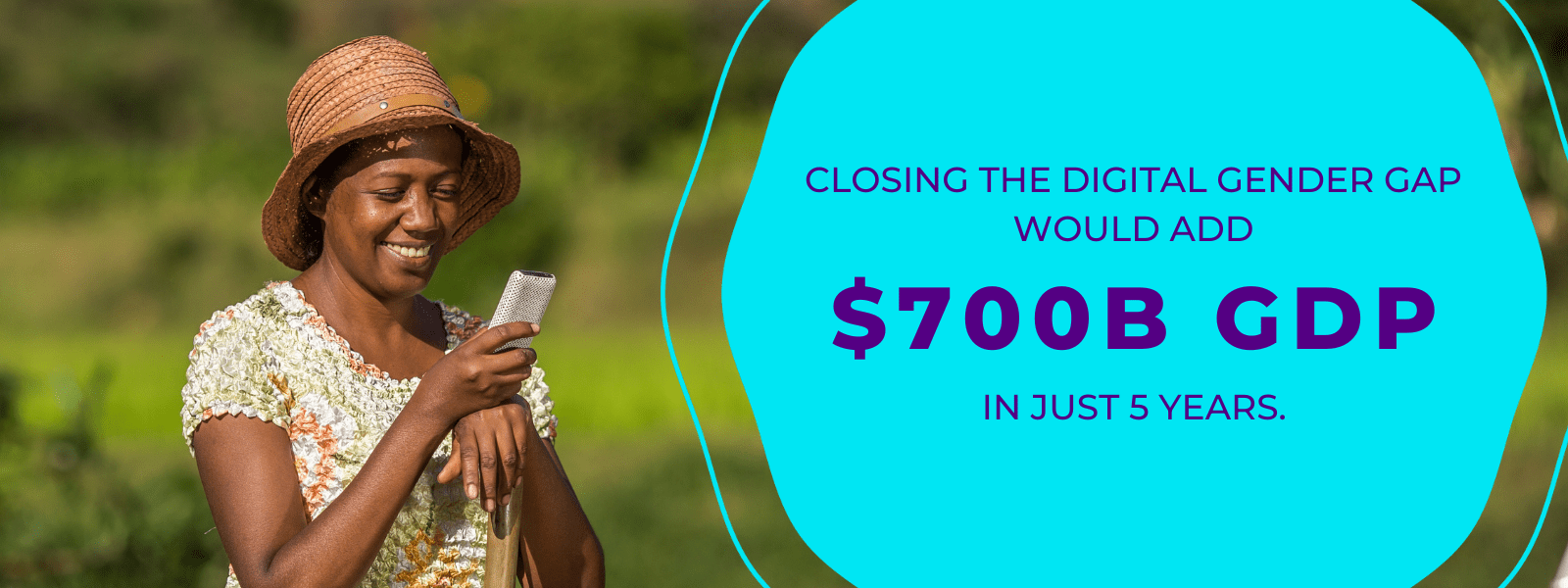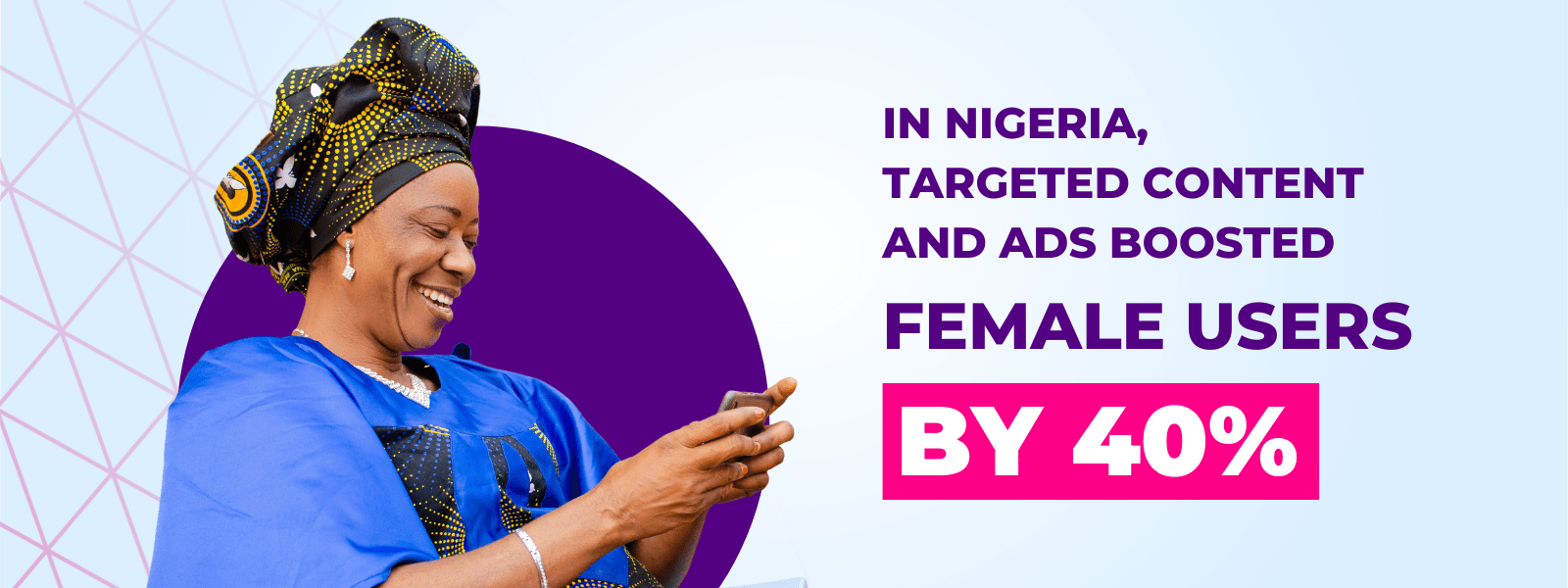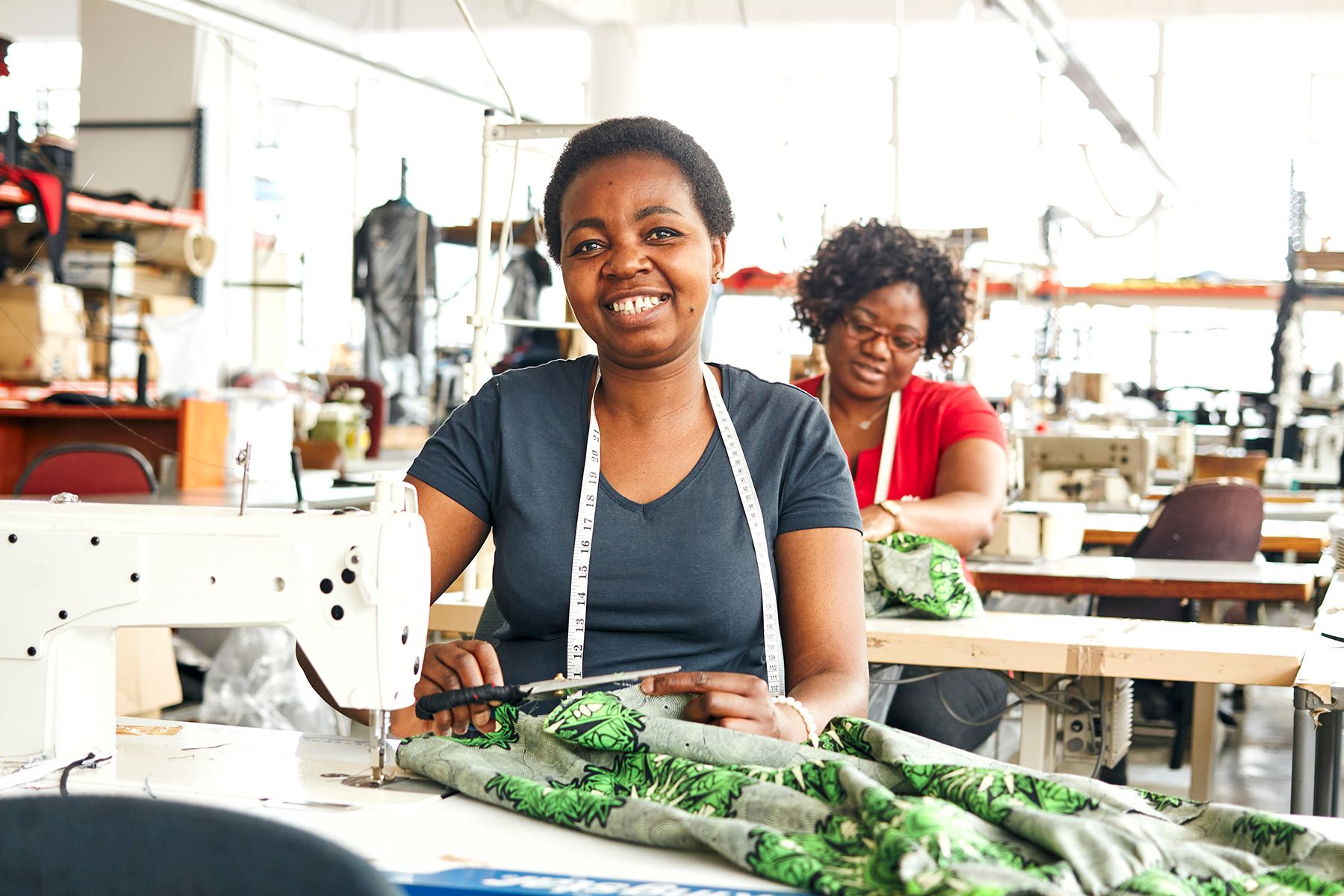Last year, the digital divide for women in lower- and middle-income countries not only persisted but widened for the second year in a row.
This has significant repercussions, limiting women’s access to important information and services, their participation in the digital economy and their ability to use technology for personal growth.
The growing divide presents a notable barrier to achieving the Sustainable Development Goals (SDGs) in underserved communities.
Closing the digital gender gap in countries with lower- and middle-income levels could add $700 billion to GDP growth in just five years, according to GSMA research.
In 2024 there is a good chance that the digital divide can start to narrow, but it will take a concerted effort from governments, non-profit organizations and private sector companies alike.
In this article, we’ll share strategies and lessons learned in our work to engage young women and girls who are digitally disconnected.

What is the digital divide?
Simply put, the digital divide is the gap between people with and without access to modern technology.
While the term was originally focused on access to the internet, it has since evolved to encompass a broader spectrum of digital resources.
The majority of people impacted by the digital divide live in lower- and middle-income countries with limited digital technology and internet access, with proven unequal access for women.
Barriers include a lack of access to affordable and reliable internet connectivity, limited digital literacy and cultural and social norms that restrict women’s access to technology.
Looking at internet penetration in sub-Saharan Africa, GSMA reported:
- Women use mobile internet 37% less than men.
- Rural communities use mobile internet 54% less than urban communities.
- The poorest 40% of the population use mobile internet 54% less than the richest 40%.
Despite these challenges, organizations are working to close the digital divide by using low-tech mobile solutions to connect with underserved communities.
Mobile phone penetration in sub-Saharan Africa is currently at 43% according to GSMA, while internet user penetration stands at 25%.
For digital campaigns for non-internet users, SMS messages are widely used. While effective in terms of reach, they lack engagement and isolate those with low literacy skills.
Viamo uses voice technology to help organizations deliver important information and services to people without internet access, particularly for those with low literacy rates.
The Viamo Platform is now available to >200M subscribers in 20 countries and delivers >70M monthly voice messages in people’s native languages, for free, on any mobile device.
Recent developments in Nigeria have resulted in significant progress in addressing the digital divide. The country is now a major contributor to the Viamo Platform, with 1.35 million monthly active users making up 20% of the global audience.
Our engagement with women in Nigeria has seen a remarkable 40% increase, with women now forming 38% of our total Nigerian listenership.
By understanding and catering to the unique landscape of Nigeria, we’ve created content that speaks directly to the needs and interests of Nigerian women, leading to this notable rise in engagement.
This underscores the importance of culturally sensitive content and outreach strategies in closing the digital gender gap.

Causes of the digital divide
According to GSMA, the digital gender divide widened in 2022 and 2023, marking the first time this has happened since they began tracking it.
The gender gap remains unchanged – women in countries with lower- and middle-income levels are 19% less likely to use mobile internet, resulting in 310 million fewer women online than men.
Some of the key causes of the digital divide include limited digital infrastructure, high-cost devices, lack of high-speed internet access, low digital literacy and cultural and social barriers.
These factors disproportionately affect women, creating barriers to education, economic opportunities and healthcare access.
By understanding the causes of the digital divide, organizations can tailor their outreach to bridge the gap and reach more women in under-resourced and rural communities through low-tech digital tools.
The following barriers for women are frequently observed in countries with lower- and middle-income levels:
- Gender inequality in education: Lower educational opportunities and digital literacy for women exacerbate the digital divide.
- Restrictive socio-cultural norms: Traditional gender roles limit women’s exposure to and participation in the digital world, including restrictions on owning a digital device.
- Economic challenges: Financial constraints and limited employment opportunities hinder women’s ability to afford digital tools and internet connectivity.
- Online Harassment and Safety Issues: Concerns about online safety and harassment deter active digital participation among women.
Consequences of the digital divide
The digital divide in countries with lower- and middle-income levels presents major challenges, for governments, organizations and individuals alike.
This gap contributes to economic and social disparities, limiting opportunities for education, healthcare and the digital economy.
Economically, this can look like…
- Roadblock to economic development: The lack of internet services and tech access in sub-Saharan Africa significantly hinders economic growth. With limited access to internet infrastructure, people and businesses are unable to participate fully in the digital economy. This means they miss out on opportunities for innovation, entrepreneurship and digital market access.
- Job market limitations: In an increasingly digital world, the job market favors those who have digital skills. The digital divide restricts job opportunities for millions of people, compounding unemployment and underemployment issues, particularly among women and low-income communities.
- Impact on small businesses: For small and medium-sized enterprises (SMEs), the digital divide translates into limited market reach and inefficient operations. This results in reduced competitiveness and weakens the growth potential of these businesses, which are often key drivers of economic development in the region.
Socially, this can look like…
- Educational attainment: People without internet access are unable to benefit from online learning, online courses and educational technology that can enhance learning outcomes.
- Healthcare access: The digital divide limits access to critical health information, telemedicine services and digital health records, affecting the overall health outcomes of the population, especially in remote and rural areas.
- Social exclusion: Without digital access, people are socially excluded in various aspects of life, lacking the means to connect, communicate and access information that is increasingly only available to internet users. This isolation can have profound implications for civic participation, quality of life and community development.
By understanding the specific challenges faced by different groups, especially women, strategies can be developed to provide targeted interventions and improve digital literacy and access.
Viamo’s approach, utilizing voice technology, showcases how low-tech solutions can effectively reach under-resourced communities, providing people with valuable information and services on non-internet, mobile phones.
One project in Jordan, done in collaboration with UN Women and Tech Tribes, set out to provide women with digital literacy skills.
The campaign aimed to provide business and financial education to Jordanian and Syrian women in refugee host communities through digital platforms such as SMS, IVR and WhatsApp Chatbots.
Research on user engagement, user experience optimization and personalized content contributed to maintaining high engagement rates.
Our opt-in and engagement rates improved through the development of content for various channels. SMS notifications and reminders were also used to increase awareness.
The digital-first initiative reached 1,482 women and delivered 26,000 interactive messages, showcasing the effectiveness of tailored strategies in building economic resilience.
Bridging the gender divide
Bridging this gap requires targeted strategies that address the specific barriers women face.
Tailored strategies for women’s digital inclusion
The Viamo Platform’s role in enhancing women’s digital access
Viamo’s approach to bridging the digital divide for women reflects an understanding of the unique challenges they face:
- Voice-first tech: Viamo uses voice technology, IVR, that allows people to access information through simple voice commands on basic mobile phones. This is particularly beneficial for women with limited literacy skills or lack access to broadband internet or smartphones.
- Local language content: Recognizing the diversity of languages across the millions of people who call the Viamo Platform monthly, we ensure content is available in local dialects, making it more accessible and understandable to a broader range of women.
- Focus on relevant topics: The Viamo Platform provides information on topics like healthcare, agriculture and finance – all are crucial for women’s quality of life. The content is tailored to be relevant and beneficial to their daily lives and challenges.
- Partnerships for wider reach: By collaborating with NGOs, governments and organizations, relevant content is available for women on the Viamo Platform.
- Feedback mechanisms: The Viamo Platform incorporates feedback mechanisms, allowing continuous improvement of services based on users’ needs and preferences, ensuring the Platform remains user-centric and effective.
It is crucial for technology companies to work towards closing the digital divide in sub Saharan Africa as internet access can provide opportunities for education, healthcare and economic empowerment.
Initiatives by organizations such as the Gates Foundation and GSMA also play a significant role in bridging the digital divide, supporting companies like Viamo in their efforts to connect underserved communities and closing the gender gap.
Viamo was awarded a $4.3 million dollar investment from the Bill & Melinda Gates Foundation to improve and expand access to health information for vulnerable women and girls in key developing nations.
By implementing these strategies and leveraging voice technology, Viamo and our partners are making significant strides in closing the gender gap in digital access.
The path forward
Bridging the digital divide is crucial for the progress of digital divide countries, especially for women who are often left behind in terms of access to technology and internet connectivity.
Viamo has partnered with over 700 organizations and made significant progress in narrowing the digital divide through innovative mobile technology solutions that reach even the most remote communities.
Initiatives focusing on addressing unequal access are key. Collaboration between governments, non-profit organizations and private sector companies is essential in ensuring equitable access to technology and internet connectivity.
By working together, these stakeholders can create sustainable solutions that empower women and communities, ultimately leading to inclusive economic growth and development in sub-Saharan Africa.
Want to learn more on how Viamo can help you reach your digital goals? Reach out to our team today.




